Effectiveness and Advancements of Heritage Revitalizations on Community Planning: Case Studies in Hong Kong
Abstract
:1. Introduction
2. Heritage Revitalization and Community Planning
2.1. Overseas Revitalization Experiences
- (1)
- Germany
- (2)
- Japan
- (3)
- Singapore
- (4)
- United Kingdom
- (5)
- Lithuania
2.2. Literature Review
3. Research Methodology
4. Cases Studies in Hong Kong
- (1)
- Tai Kwun
- (2)
- Police Married Quarters
- (3)
- Mei Ho House
- (4)
- The Mills
5. Findings and Discussions
5.1. Appearance and Components
- (1)
- Side-Effects in Keeping Appearances
- (2)
- New Utilization of the Revitalized Building Components
5.2. Improvement of Building Techniques and Planning
- (1)
- Advancement of Adopted Building Technologies
- (2)
- New Planning in Building Revitalization
5.3. Public Acceptance
5.4. Implications
6. Conclusions
Author Contributions
Funding
Institutional Review Board Statement
Informed Consent Statement
Data Availability Statement
Conflicts of Interest
Appendix A
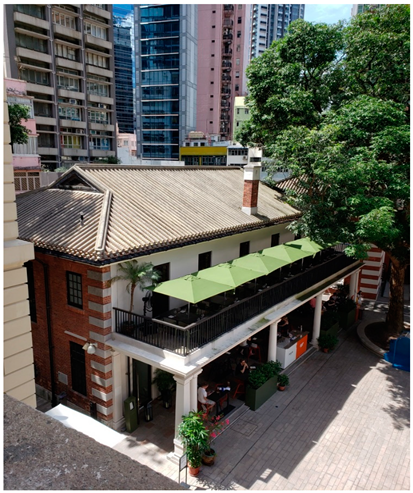 | 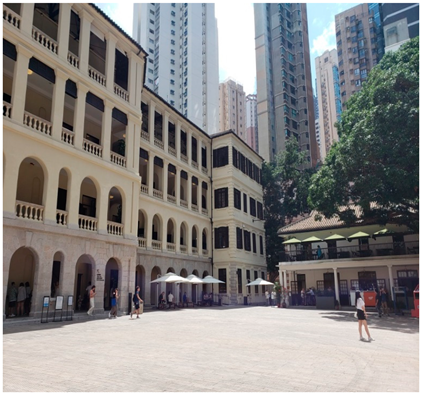 |
| Photo A | Photo B |
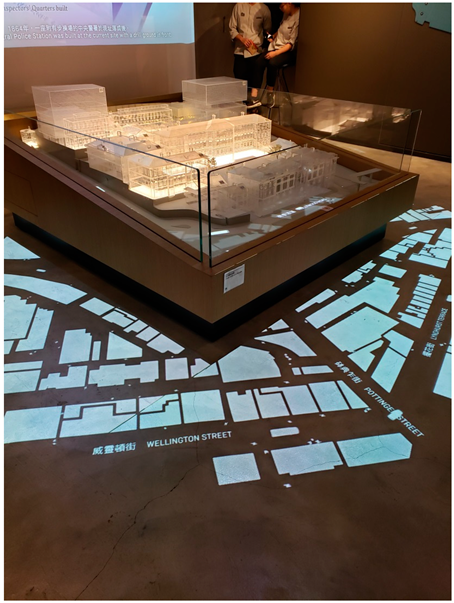 | 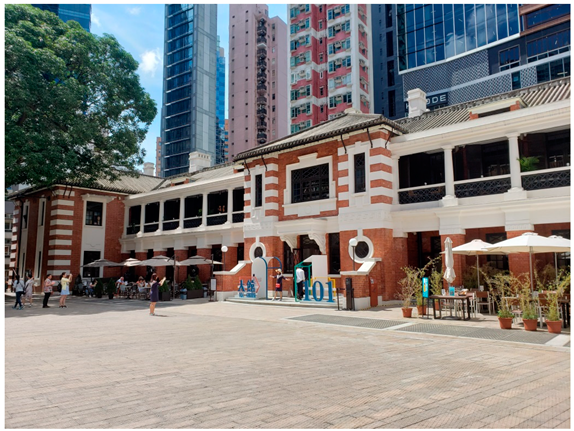 |
| Photo C | Photo D |
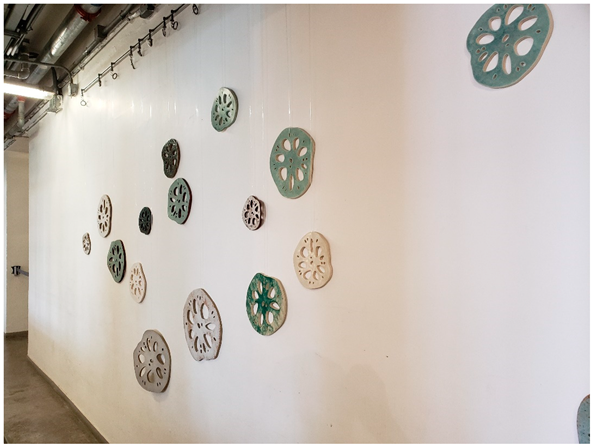 | 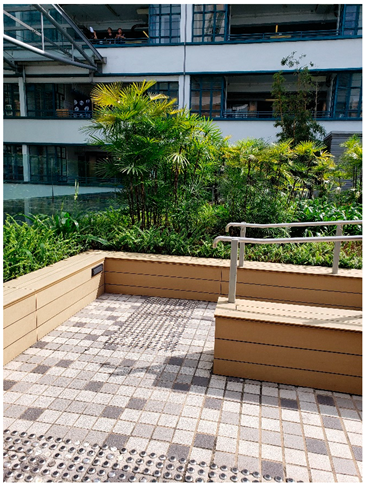 |
| Photo E | Photo F |
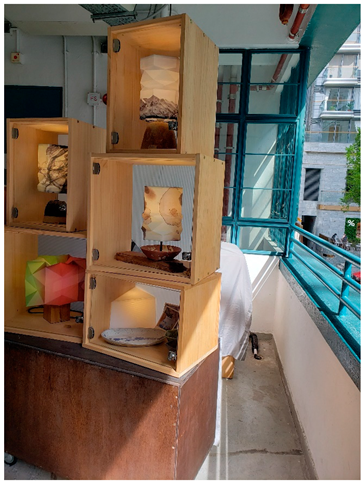 |  |
| Photo G | Photo H |
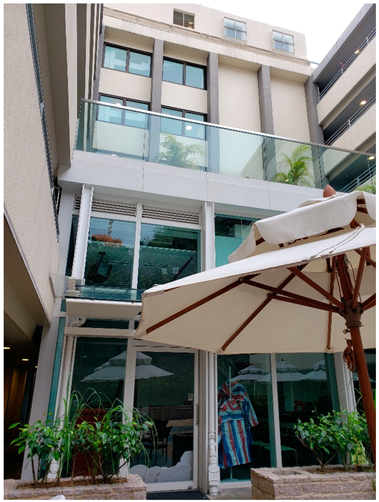 | 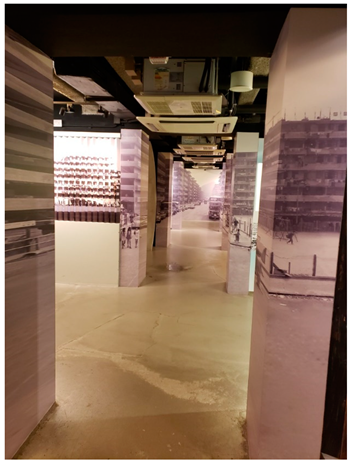 |
| Photo I | Photo J |
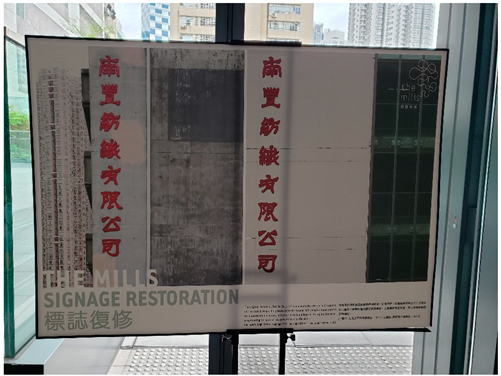 | 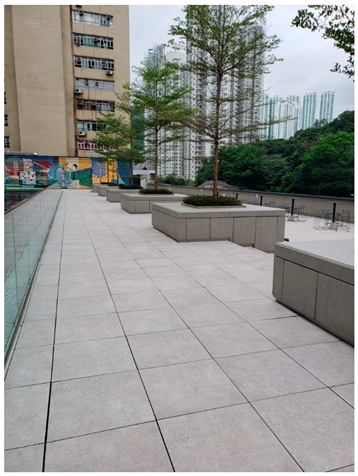 |
| Photo K | Photo L |
 | |
| Photo M |
References
- The Commissioner for Heritage’s Office. Conserve and Revitalise Hong Kong Heritage. 2017. Available online: https://www.heritage.gov.hk/en/rhbtp/about.htm (accessed on 26 April 2020).
- Vetter, D. Biggest Source of Air Pollution in Hong Kong? It’s Shipping, Not Cars, or Mainland China. SCMP. 2018. Available online: https://www.scmp.com/ (accessed on 19 November 2019).
- Census and Statistics Department. Table E489: Land Area, Mid-Year Population and Population Density by District Council District. 2019. Available online: https://www.censtatd.gov.hk/hkstat/sub/sp150.jsp?productCode=D5320189 (accessed on 26 April 2022).
- Knippschild, R.; Zöllter, C. Urban Regeneration between Cultural Heritage Preservation and Revitalization: Experiences with a Decision Support Tool in Eastern Germany. Land 2021, 106, 547. [Google Scholar] [CrossRef]
- Oevermann, H. Good practice for industrial heritage sites: Systemization, indicators, and case. J. Cult. Herit. Manag. Sustain. Dev. 2020, 10, 157–171. [Google Scholar] [CrossRef]
- Chan, K. Revitalization in Kyoto. 2019. Available online: http://www.pmq.org.hk/leisureculture/revitalization-in-kyoto/ (accessed on 20 January 2020).
- UNESCO World Heritage Centre. Kyoto City Landscape Policy. 2007. Available online: https://whc.unesco.org/document/116517 (accessed on 14 October 2019).
- Ronchi, L. Lighting, Color, Environment and Complexity an Abridged Historical Review; Lucia Ronchi: Firenze, Italy, 2015. [Google Scholar]
- Yamamura, T. Pop culture contents and historical heritage: The case of heritage revitalization through ‘contents tourism’in Shiroishi city. Contemp. Jpn. 2018, 30, 144–163. [Google Scholar] [CrossRef]
- Urban Redevelopment Authority. Heritage and Modernity in Singapore’s Urban Renewal. 2013. Available online: http://citiesofmigration.ca/good_idea/heritage-and-modernity-in-singapores-urban-renewal/ (accessed on 2 March 2020).
- Zhao, S. As Heritage and Historic Buildings Succumb to Redevelopment, Is It too Late to Save Old Hong Kong from the Wrecking Ball? SCMP. 2018. Available online: https://www.scmp.com/ (accessed on 11 February 2021).
- Yeoh, B.S.A.; Kong, L. Singapore’s Chinatown: Nation Building and Heritage Tourism in a Multiracial City. 2012. Available online: https://ink.library.smu.edu.sg/cgi/viewcontent.cgi?article=3507&context=soss_research (accessed on 6 April 2020).
- Paardekooper, R. The Value of an Archeological Open-Air Museum Is in Its Use; Sidestone Press: Leiden, The Netherlands, 2012. [Google Scholar]
- Olinsson, S.B.; Fouseki, K. Social entrepreneurship for sustainable heritage management–the case of open-air museums. J. Cult. Herit. Manag. Sustain. Dev. 2019, 9, 486–499. [Google Scholar] [CrossRef]
- Dogan, H.A. Assessment of the perception of cultural heritage as an adaptive re-use and sustainable development strategy. J. Cult. Herit. Manag. Sustain. Dev. 2019, 9, 430–443. [Google Scholar] [CrossRef]
- Raugaliene, J. The Revitalization of Vilnius Old Town, 1995–2005. Glob. Urban Dev. Mag. 2008, 4, 1–12. [Google Scholar]
- Holland, S. Weaving Policy, People & Place Together, Revitalizing Broadway East What Does “Revitalizing” Mean. 2014. Available online: https://www.mpnh.org/~Assets/Document/Wpppt/Revitalization--%20Working%DEfinition1.pdf (accessed on 12 June 2022).
- Grazuleviciute-Vileniske, I.; Urbonas, V. Urban regeneration in the context of post-Soviet transformation: Lithuanian experience. J. Cult. Herit. 2014, 15, 637–643. [Google Scholar] [CrossRef]
- Ramlee, M.; Omar, D.; Yunus, R.; Samadi, Z. Revitalization of Urban Public Spaces: An Overview. Procedia-Soc. Behav. Sci. 2015, 201, 360–367. [Google Scholar] [CrossRef] [Green Version]
- University of Pennsylvania. Urban Planning. 2013. Available online: https://kwhs.wharton.upenn.edu/term/urban-planning/ (accessed on 7 April 2020).
- PPP Knowledge Lab. Urban Revitalization. 2019. Available online: https://pppknowledgelab.org/sectors/urban-revitalization (accessed on 21 May 2020).
- McNamara, C. Field Guide to Consulting and Organizational Development with Nonprofits; Authenticity Consulting: Minneapolis, MN, USA, 2006. [Google Scholar]
- Jacobus, R.; Hickey, M. Commercial Revitalization Planning Guide: A Toolkit for Community Based Organizations; The Local Initiatives Support Corporation Center for Commercial Revitalization: New York, NY, USA, 2006. [Google Scholar]
- Development Bureau. Revitalising Historic Buildings through Partnership Scheme. 2008. Available online: https://www.heritage.gov.hk/en/rhbtp/about.htm (accessed on 10 December 2019).
- Alpopi, C.; Manole, C. Integrated Urban Regeneration-Solution for Cities Revitalize. Procedia Econ. Financ. 2013, 6, 178–185. [Google Scholar] [CrossRef] [Green Version]
- Mesthrige, J.; Wong, J.; Lin, N.Y. Conversion or redevelopment? Effects of revitalization of old industrial buildings on property values. Habitat Int. 2018, 73, 53–64. [Google Scholar] [CrossRef]
- Pang, L.F. [Revitalization Structure: Hard to Step Further] PMQ, a Non-Stop Controversy. Ming Pao Weekly. 2017. Available online: https://www.mpweekly.com/ (accessed on 27 June 2021).
- Hodge, D. Urban Geography. In Gentrification of the City; Smith, N., Williams, P., Eds.; National Geographic: Washington, DC, USA, 2013; Volume 9, pp. 442–444. [Google Scholar]
- National Low Income Housing Coalition. Gentrification and Neighborhood Revitalization: What’s the Difference? 2019. Available online: https://nlihc.org/resource/ (accessed on 11 January 2021).
- Mullin, J.; Kotval, Z. Measuring the Effectiveness of Downtown Revitalization Strategies. 2003. Available online: https://scholarworks.umass.edu/cgi/viewcontent.cgi?article=1022&context=larp_faculty_pubs (accessed on 8 November 2021).
- Yung, E.H.; Chan, E.H. Problem issues of public participation in built-heritage conservation: Two controversial cases in Hong Kong. Habitat Int. 2011, 35, 457–466. [Google Scholar] [CrossRef]
- Cheung, E.; Chan, A.P. Revitalising historic buildings through partnership scheme: A case study of the Mei Ho House in Hong Kong. Prop. Manag. 2012, 30, 176–189. [Google Scholar] [CrossRef]
- Shipley, R.; Reeve, A.; Walker, S.; Grover, P.; Goodey, B. Townscape heritage initiatives evaluation: Methodology for assessing the effectiveness of heritage lottery fund projects in the United Kingdom. Environ. Plan. C Gov. Policy 2004, 22, 523–542. [Google Scholar] [CrossRef]
- Hou, H.; Wu, H. A case study of facilities management for heritage building revitalisation. Facilities 2019, 38, 201–217. [Google Scholar] [CrossRef]
- Ng, J. Developer’s NGO in Running to Revitalise Wan Chai Blue House. SCMP. 2009. Available online: https://www.scmp.com/ (accessed on 19 August 2020).
- The Hong Kong Jockey Club. Heritage at Tai Kwun. 2019. Available online: https://www.taikwun.hk/en/taikwun/about/heritage (accessed on 11 January 2020).
- Kao, E. Central Police Station Is Now the Tai Kwun Centre for Heritage and Arts, Where Fond Hong Kong Tales Live on. SCMP. 2018. Available online: https://www.scmp.com/ (accessed on 30 June 2020).
- Legislative Council. 400IO–Transformation of the Former Police Married Quarters on Hollywood Road into a Creative Industries Landmark. 2011. Available online: https://www.legco.gov.hk/yr10-11/english/fc/pwsc/papers/pwsc0615pwsc-80-e.pdf (accessed on 29 December 2019).
- Legislative Council. 7QW–Revitalisation Scheme–Revitalisation of Mei Ho House as City Hostel. 2010. Available online: https://www.legco.gov.hk/yr09-10/english/fc/pwsc/papers/p10-10e.pdf (accessed on 8 May 2021).
- In, N.H. The Mills: New Art and Cultural Complex for Hong Kong Perspective. 2018. Available online: https://www.perspectiveglobal.com/architecture/the-mills/ (accessed on 16 September 2021).
- The Mills. The Mills’ Event. 2020. Available online: https://www.themills.com.hk/chi/event/ (accessed on 1 February 2022).
- The Hong Kong Jockey Club. The Architect + Masterplanning. 2019. Available online: https://www.taikwun.hk/en/taikwun/conservation/project_team (accessed on 20 October 2021).
- Lee, H.Y.; Distefano, L. New Design in Old Buildings: Innovative Revitalization of Heritage Buildings [Lecture Notes]. The University of Hong Kong. 18 April 2015. Available online: https://hub.hku.hk/handle/10722/248941 (accessed on 10 January 2022).
- Kwok, M.T.; Ho, Y.W. Weekly–Blue House: An Unsuccessful Experiment Regarding the Community. HK01. 2017. Available online: https://www.hk01.com/ (accessed on 1 September 2021).
- Moon, L. Discover Defining Hong Kong Architecture, from the Ultra-Modern to Colonial Relics. SCMP. 2017. Available online: https://www.scmp.com/ (accessed on 18 January 2022).
- Legislative Council. Updated Background Brief on Heritage Conservation Initiatives. 2019. Available online: https://www.legco.gov.hk/yr18-19/english/panels/dev/papers/dev20190122cb1-456-6-e.pdf (accessed on 31 July 2021).
- Antiquities Advisory Board. Report on the Policy Review on Conservation of Built Heritage. 2014. Available online: http://www.aab.gov.hk/form/AAB_Report_e.pdf (accessed on 5 October 2021).
- The Mills. Original Staircase. 2020. Available online: http://www.themills.com.hk/en/heritages/original-staircase/ (accessed on 21 March 2021).
- VenueHub. Exhibition. 2020. Available online: https://www.venuehub.hk/ (accessed on 30 November 2020).
- Tai Kwun. Self-Guided Walks. 2020. Available online: https://www.taikwun.hk/en/programme/detail/self-guided-walks/101 (accessed on 5 June 2021).
- The Mills. Centre for Heritage, Arts and Textile Pre-Opening Exhibition–(in)Tangible Reminiscence. 2018. Available online: https://www.themills.com.hk/en/event/centre-for-heritage-arts-and-textile-pre-opening-exhibition-intangible-reminiscence/ (accessed on 6 June 2021).
- Sing Tao Daily. A Year after the Opening of Tai Kwun: Meeting the 2.9 Million Visitor. 2019. Available online: http://std.stheadline.com/ (accessed on 16 July 2021).
- Leisure and Cultural Services Department. Statistics Report. 2019. Available online: https://www.lcsd.gov.hk/en/aboutlcsd/ppr/statistics/cultural.html (accessed on 12 December 2020).
- The Hong Kong Jockey Club. Tai Kwun Welcomes One Million Visitors: A Shining Example of Heritage Conservation in Hong Kong. 2018. Available online: https://corporate.hkjc.com/corporate/corporate-news/english/2018-10/news_2018100301647.aspx (accessed on 1 October 2021).
- Au, L.S. Wan Chai Heritage: Green House Opts to Be Opened to the Public Due to only 35% Public Recognition. HK01. 2018. Available online: https://www.hk01.com/ (accessed on 14 February 2020).
- LCSD. Statistics Report. 2020. Available online: https://www.lcsd.gov.hk/en/aboutlcsd/ppr/statistics/cultural.html (accessed on 23 August 2021).
- Advancing Public Transport. Public Transport as an Instrument for Urban Regeneration. 2018. Available online: https://www.uitp.org/sites/default/files/cck-focus-papers-files/Policy%20Brief%20-%20PT%20and%20Urban%20Regeneration-BAT-WEB-300DPI.pdf (accessed on 26 March 2022).
- Tsang, F.T. New Minibus Link for Accessing the Mills: Red Minibus Provides Free Shuttle Bus Service to the Visitors. HK01. 2019. Available online: https://www.hk01.com/ (accessed on 2 October 2020).
- Li, K. From BIM to HIM (Heritage Information Management). Architectural Services Department. 2014. Available online: https://damassets.autodesk.net/content/dam/autodesk/www/campaigns/hk-bim-awards-site-project/2014-preparation/architectural-services-department.pdf (accessed on 28 December 2021).
- Urban Renewal Authority. About URA. 2017. Available online: https://www.ura.org.hk/en/about-ura (accessed on 22 February 2022).
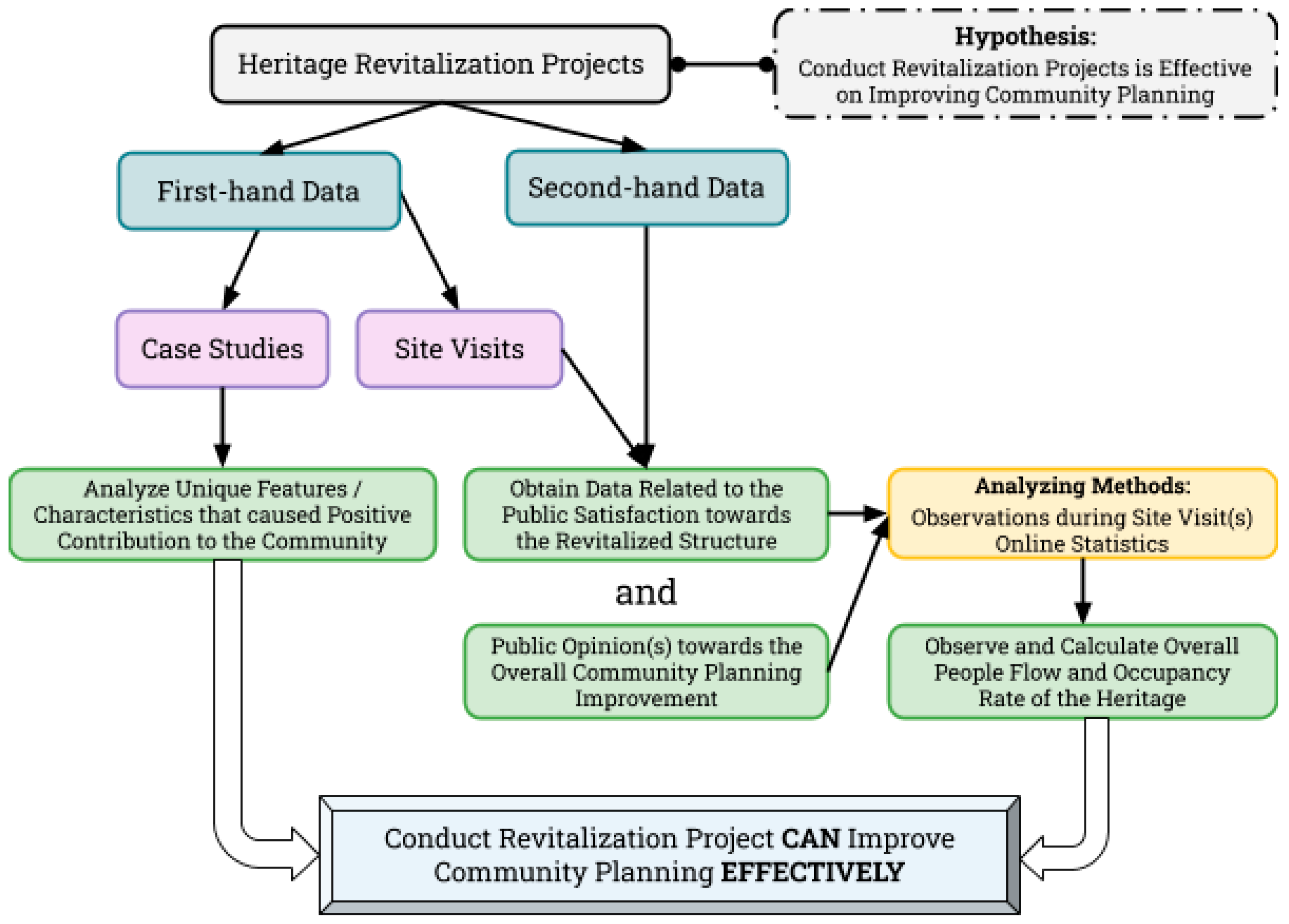

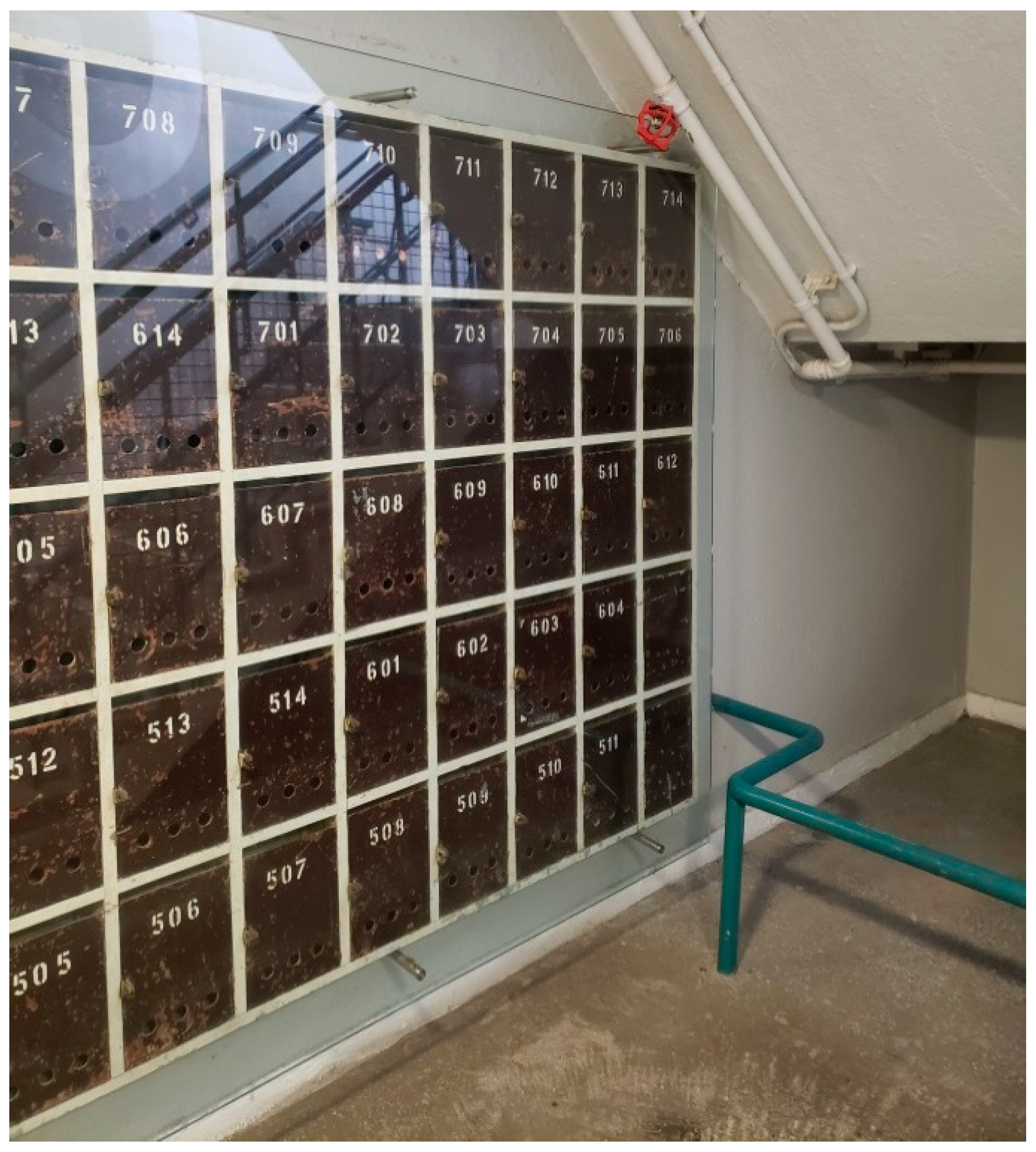

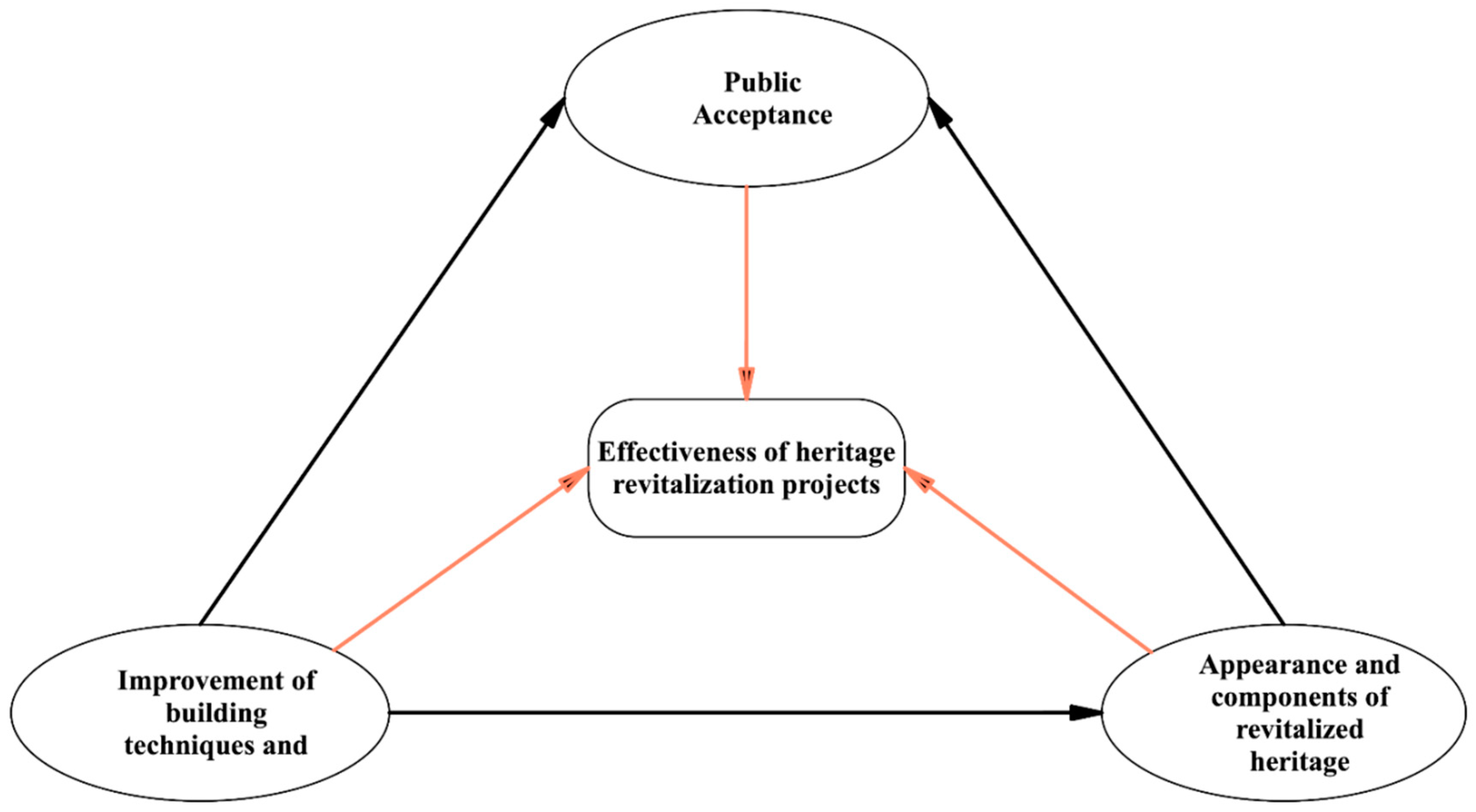
| Country | Main Feature of Revitalization | Example |
|---|---|---|
| Germany | a. Stagnation or population decline; b. Integration with landscape design. | Zollverein Park |
| Japan | a. Strict regulations on design standards of revitalizations; b. Taking advantage pop culture of Japan. | Itonowa in the Shimabara district of Kyoto Shiroishi city, Miyagi prefecture |
| Singapore | a. Strict revitalizing regulations; b. Offered a unique style to the revitalized buildings. | Singapore Chinatown |
| United Kingdom | a. Paid attention to visitors’ feedback; b. Care about preservation and recreation of craft. | Open-air museums |
| Lithuania | a. Reuse solution; b. Public attitude. | Vilnius Old Town |
| Aspect | Description | Source |
|---|---|---|
| Attractive appearance and components | Are the appearance and components of heritage buildings attractive after the revitalization? | [32,33] |
| Creative building techniques and planning methods | Are there any creative building techniques or planning methods proposed and applied in the heritage revitalization? | [32,33] |
| Public acceptance | Can the local citizens accept the revitalized heritage building? | [31,32,34] |
| Project Name | Tai Kwun | PMQ | Mei Ho House | The Mills |
|---|---|---|---|---|
| Original use | Central police station compound | Central school; former Hollywood road police married quarters | Public housing | Nan Fung Cotton Mills |
| Current use | Centre for heritage and arts. | Creative industries landmark | Museum; youth hotel | Centre for heritage, arts and textile; fabrica; shopfloor. |
| Built time | Mid-19th century | 1862 | 1954 | 1954 |
| Revitalization time | 2011–2018 | 2012–2014 | 2011–2013 | 2014–2018 |
| Area | 16 buildings | 6013 m2 | 6750 m2 | 24,500 m2 |
| Cost | HKD 3.8 billion | HKD 0.577 billion | HKD 0.22 billion | HKD 0.7 billion |
| Aspect | Appearances and Components | Building Technologies and Planning | Contributions |
|---|---|---|---|
| Cases | |||
| Tai Kwun | 1. The building was conserved overall (Pseudo Conservation) a. Rooftop structure was maintained (Photo A). b. External Wall was repainted (Photo B). c. Two new buildings were constructed, i.e., JC Cube and JC Contemporary. 2. Staircases were reinforced. 3. Cultural drawings were preserved. | 1. 3D Visualization was introduced in the building interior: for facilitating the quality of the exhibition (Photo C). | 1. Information boards were posted. 2. Photo-taking Booths were set up (Photo D). 3. Round trips and exhibitions were promoted and open to the public. - Indicated in Figure 2. 4. Stores selling traditional Chinese products and Restaurants are stationed: For art and cultural development [42]. |
| Police Married Quarters | 1. The building was conserved overall (Pseudo Conservation). 2. Representable former elements were conserved and exhibited. - For example, the mailboxes indicated in Figure 3. 3. New art paintings were drawn on building elements (Photo E). | 1. A rooftop garden was constructed (Photo F). 2. A new multi-functional hall was constructed. - For example, the Qube. | 1. Stores selling products by local designers. 2. The store “Taste Library” was stationed: For promoting the local culture. 3. Design Portraits were found (Photo G). |
| Mei Ho House | 1. The building was conserved overall (Pseudo Conservation). - H-shape Housing type was maintained (Photo H). 2. External Wall was repainted. | 1. Solar panels were installed on the rooftop. 2. Curtain walls were installed (Photo I). | 1. Mei Ho House museum was constructed (Photo J): For introducing history of Shek Kip Mei. |
| The Mills | 1. The building was conserved overall (Pseudo Conservation). 2. Former components were used for decoration. 3. Logo words were retained with mosaic tiles (Photo K). | 1. Lots of glass walls were installed: For more natural sunlight, as indicated in Figure 4. 2. Glass link bridge was constructed: For connecting two blocks 3. A rooftop garden was constructed (Photo L). 4. Columns were strengthened. | 1. Information boards were posted. 2. Photo-taking booths were set up. 3. An art center was constructed (Photo M). 4. Workshops related to art and textile are held. |
Publisher’s Note: MDPI stays neutral with regard to jurisdictional claims in published maps and institutional affiliations. |
© 2022 by the authors. Licensee MDPI, Basel, Switzerland. This article is an open access article distributed under the terms and conditions of the Creative Commons Attribution (CC BY) license (https://creativecommons.org/licenses/by/4.0/).
Share and Cite
Lam, E.W.M.; Zhang, F.; Ho, J.K.C. Effectiveness and Advancements of Heritage Revitalizations on Community Planning: Case Studies in Hong Kong. Buildings 2022, 12, 1065. https://doi.org/10.3390/buildings12081065
Lam EWM, Zhang F, Ho JKC. Effectiveness and Advancements of Heritage Revitalizations on Community Planning: Case Studies in Hong Kong. Buildings. 2022; 12(8):1065. https://doi.org/10.3390/buildings12081065
Chicago/Turabian StyleLam, Edmond W. M., Fan Zhang, and Jessie K. C. Ho. 2022. "Effectiveness and Advancements of Heritage Revitalizations on Community Planning: Case Studies in Hong Kong" Buildings 12, no. 8: 1065. https://doi.org/10.3390/buildings12081065
APA StyleLam, E. W. M., Zhang, F., & Ho, J. K. C. (2022). Effectiveness and Advancements of Heritage Revitalizations on Community Planning: Case Studies in Hong Kong. Buildings, 12(8), 1065. https://doi.org/10.3390/buildings12081065






